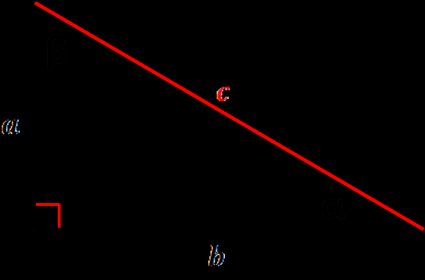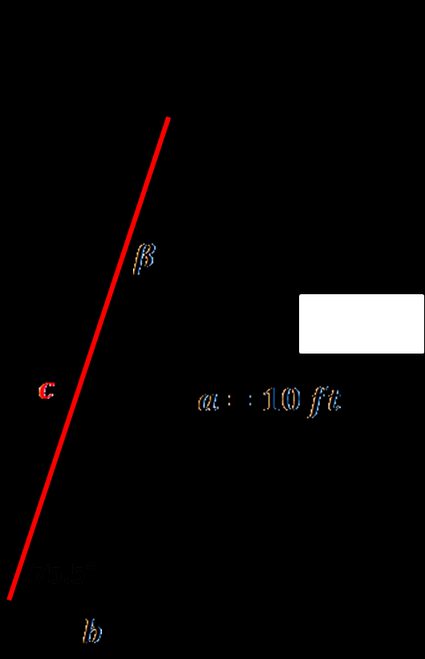How To Find The Hypotenuse Adjacent And Opposite
Hypotenuse Figurer
Created by Hanna Pamuła , PhD candidate
Reviewed by
Bogna Szyk and Jack Bowater
Concluding updated:
Feb 15, 2022
- What is the hypotenuse of a triangle
- Hypotenuse of a triangle formula
- How to find the hypotenuse of a right triangle with this hypotenuse calculator?
- FAQ
With this hypotenuse figurer y'all will chop-chop find this longest side of a right triangle. If you want to know what is the hypotenuse of a right triangle, how to find it and what is the hypotenuse of a triangle formula, you lot'll find the answer below, with a uncomplicated case to clear things up. Don't wait any longer, requite this hypotenuse figurer a try!
What is the hypotenuse of a triangle
A hypotenuse is the longest side of a right triangle. It'south the side that is opposite to the correct bending (90°). Hypotenuse length may exist constitute, for example, from the Pythagorean theorem.
Hypotenuse of a triangle formula

This hypotenuse estimator has a few formulas implemented - this way, we made sure it fits different scenarios you may run into. You tin can discover the hypotenuse:
- Given two right triangle legs
Use the Pythagorean theorem to summate the hypotenuse from right triangle sides. Take a foursquare root of sum of squares:
-
c = √(a² + b²)

- Given angle and one leg
-
c = a / sin(α) = b / sin(β), from the constabulary of sines
- Given area and one leg
Equally expanse of a right triangle is equal to a * b / 2, then
-
c = √(a² + b²) = √(a² + (area * ii / a)²) = √((expanse * two / b)² + b²)
How to detect the hypotenuse of a correct triangle with this hypotenuse computer?

Permit's calculate how long should the ladder be if nosotros want to rescue a kitten from a 10 ft roof. The calculator helps to find the ladder length from the footing to the edge of the roof, but don't forget about a ladder part which should extend over the edge!
- Choose the choice needed for your calculations. We know that our roof is 10 ft in height and that the safest angle for a ladder is ~75.5°. From dropdown list of given box select the pick: angle ∡ and one side.
- Change the units to feet.

-
Enter the given values. Our leg a is 10 ft long, and the α angle between ladder and ground equals 75.five°.
-
Ladder length, which is our correct triangle hypotenuse, appears! It'due south equal to 10.33 ft.
The bending β = 14.v° and leg b = 2.586 ft are displayed likewise. The 2nd leg is also an important parameter, as it tells you how far the ladder should be removed from the wall (or rather from a roof edge). The general principle to remember is a four:ane rule - for every 4 feet of vertical height, the ladder foot should movement ane foot from the wall.
FAQ
How practice I find hypotenuse with sin?
- Perform the sin operation on the angle (not the right angle).
- Separate the length of the side opposite the angle from step i by the consequence of stride i.
- The result is the hypotenuse.
Is the hypotenuse always the longest side?
Yes, the hypotenuse is e'er the longest side, but only for right angled triangles. For isosceles triangles, the two equal sides are known equally the legs, while in an equilateral triangle all sides are known simply equally sides.
How do I find the hypotenuse next and contrary?
- Notice the longest side and label it the hypotenuse.
- The next and opposite can but be constitute if you lot choose one of the non right angled angles.
- The adjacent is the side that forms the angle of choice forth with the hypotenuse.
- The opposite is the side that does not form the angle of choice.
How practise you find the altitude of a hypotenuse?
- Describe the altitude of the hypotenuse on the triangle. The two new triangles you have created are like to each other and the master triangle.
- Separate the length of the shortest side of the main triangle past the hypotenuse of the master triangle.
- Multiply the effect by the length of the remaining side to get the length of the altitude.
- Alternatively, the angles within the smaller triangles will be the same as the angles of the main i, so you tin perform trigonometry to find it another way.
What should I do if the hypotenuse is the opposite?
If the hypotenuse is the opposite, and so you lot are because the wrong bending - you cannot use trigonometry with right angle of a triangle. Consider 1 of the other angles, and the reverse will be the side that does not form that bending.
How do I construct a perpendicular to the hypotenuse?
- Acquire a pair of compasses, a ruler, and a pen or pencil.
- Fix your pair of compasses to the length of the hypotenuse (or any length, equally long as information technology stays abiding).
- Depict a circle that has its center at one of the ends of the hypotenuse.
- Describe another circle with its center at the other end of the hypotenuse.
- Depict a line joining the two points where these circles meet. This line is the hypotenuse.
How do I notice the hypotenuse of isosceles right triangle?
- Find the length of one of the non-hypotenuse sides.
- Square the length of the side.
- Double the effect of the previous step.
- Square root the result of pace 3. This is the length of the hypotenuse.
What is the hypotenuse angle theorem?
The hypotenuse angle theorem is a fashion of testing if two correct angled triangles are congruent or not. Information technology states that if ii correct angled triangles accept a hypotenuse and an acute angle that are the same, they are congruent.
Where does the word hypotenuse come from?
The word hypotenuse comes from the Ancient Greek hypoteinousa , meaning 'stretching under (a right angle)'. This in plough comes from hypo- 'under', and teinein 'to stretch'. Another affair we have to thank the Ancient Greeks for!
How do I solve a right triangle with but the hypotenuse?
You cannot solve a right angled triangle with only the hypotenuse. This is because the other two sides and angles are notwithstanding undefined and therefore the triangle can however have many forms.
Hanna Pamuła , PhD candidate

Source: https://www.omnicalculator.com/math/hypotenuse
Posted by: baileythadmories.blogspot.com


0 Response to "How To Find The Hypotenuse Adjacent And Opposite"
Post a Comment